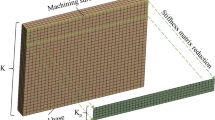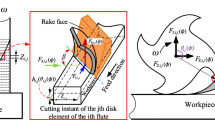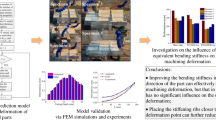Abstract
Due to the unique low rigidity of thin-walled parts, significant machining deformation may occur in the milling process. A deformation prediction model is presented in this paper while considering the effect of the removed material on the global stiffness matrix. Aiming at reducing the scale of the global stiffness matrix, the super-element method is firstly used and the scale of the stiffness matrix is significantly reduced about 30%. And then, the stiffness matrix of the in-process workpiece (IPW) is directly obtained by eliminating the contribution of the removed nodes in the global stiffness matrix. This method can avoid re-building the geometric model or re-meshing the finite element (FE) model in the machining process. To improve the inverse calculation efficiency of the stiffness matrix, a novel nodes re-sorting method is proposed based on the calculation order of the matrix blocks in LU decomposition and inverse calculation. Furthermore, the optimal stiffness direction is discussed and applying the cutting force in this direction can minimize the machining deformation. The simulation results verified the existence of the optimal stiffness direction. Finally, the simulation and experiment are carried out to validate the accuracy of the proposed model.



















Similar content being viewed by others
Data availability
All data generated in this work are included in this paper.
References
Ge GY, Du ZC, Yang JG (2020) Rapid prediction and compensation method of cutting force-induced error for thin-walled workpiece. Int J Adv Manuf Technol 106:5453–5462
Kang YG, Wang ZQ (2013) Two efficient iterative algorithms for error prediction in peripheral milling of thin-walled workpieces considering the in-cutting chip. Int J Mach Tools Manuf 73:55–61
Shi JH, Gao J, Song QH, Liu ZQ, Wan Y (2017) Dynamic deformation of thin-walled plate with variable thickness under moving milling force. Procedia CIRP 58:311–316
Wang MH, Sun Y (2014) Error prediction and compensation based on interference-free tool paths in blade milling. Int J Adv Manuf Technol 71:1309–1318
Liu SM, Shao XD, Ge XB, Wang D (2017) Simulation of the deformation caused by the machining cutting force on thin-walled deep cavity parts. Int J Adv Manuf Technol 92:3503–3517
Yan QH, Luo M, Tang K (2018) Multi-axis variable depth-of-cut machining of thin-walled workpieces based on the workpiece deflection constraint. Comput Aided Des 100:14–29
Yang D, Liu ZQ (2015) Surface plastic deformation and surface topography prediction in peripheral milling with variable pitch end mill. Int J Mach Tools Manuf 91:43–53
Zhu ZR, Yan R, Peng FY, Duan XY, Zhou L, Song K et al (2016) Parametric chip thickness model based cutting forces estimation considering cutter runout of five-axis general end milling. Int J Mach Tools Manuf 101:35–51
Mou WP, Zhu SW, Zhu MH, Han L, Jiang L (2020) A prediction model of cutting force about ball end milling for sculptured surface. Math Probl Eng
Grossi N, Sallese L, Scippa A, Campatelli G (2015) Speed-varying cutting force coefficient identification in milling. Precis Eng 42:321–334
Zhang X, Zhang J, Pang B, Zhao WH (2016) An accurate prediction method of cutting forces in 5-axis flank milling of sculptured surface. Int J Mach Tools Manuf 104:26–36
Ma JW, He GZ, Liu Z, Qin FZ, Chen SY, Zhao XX (2018) Instantaneous cutting-amount planning for machining deformation homogenization based on position-dependent rigidity of thin-walled surface parts. J Manuf Process 34:401–411
Wang JR, Quan LL, Tang K (2020) A prediction method based on the voxel model and the finite cell method for cutting force-induced deformation in the five-axis milling process. Comput Methods Appl Mech Eng 367:113110
Li ZL, Oguzhan T, Zhu LM, Yusuf A (2018) Surface form error prediction in five-axis flank milling of thin-walled parts. Int J Mach Tools Manuf 128:21–32
Oguzhan T, Yusuf A (2017) Frequency Domain updating of thin-walled workpiece dynamics using reduced order substructuring method in machining. J Manuf Sci Eng 139:7071013
Oguzhan T, Yusuf A (2018) Time-domain modeling of varying dynamic characteristics in thin-wall machining using perturbation and reduced-order substructuring methods. J Manuf Sci Eng 140:011015
Li ZL, Zhu LM (2019) Compensation of deformation errors in five-axis flank milling of thin-walled parts via tool path optimization. Precis Eng 55:77–87
Wang J, Ibaraki S, Matsubara A (2017) A cutting sequence optimization algorithm to reduce the workpiece deformation in thin-wall machining. Precis Eng 50:506–514
Huang T, Zhang XM, Jürgen L, Ding H (2018) Tool orientation planning in milling with process dynamic constraints: a minimax optimization approach. J Manuf Sci Eng 140:111002.
ANSYS Mechanical APDL Advanced Analysis Techniques Guide, ANSYS Release 14.0, ANSYS Inc. Canonsburg, USA, 2011.
Funding
This work was supported by grants from the National Natural Science Foundation of China (52005030) and the Aeronautical Science Foundation of China (2019160M5002).
Author information
Authors and Affiliations
Contributions
Xiaolin Xi proposed the method and conducted the numerical simulation. She also drafted the manuscript. Yonglin Cai and Haitong Wang discussed the prediction model and revised the manuscript. Defu Zhao conducted the experiment and processed data.
Corresponding author
Ethics declarations
Ethics approval
The authors declare that this manuscript was not submitted to more than one journal for simultaneous consideration. The submitted work is original and has not been published elsewhere in any form or language.
Consent to participate and publish
The authors declare that they consent to participate in and publish this paper.
Conflict of interest
The authors declare no competing interests.
Additional information
Publisher's note
Springer Nature remains neutral with regard to jurisdictional claims in published maps and institutional affiliations.
Appendix
Appendix
APDL command adopted in this paper is listed as below.
-
a
For the generation and use pass of the super-element
ANTYPE, SUBSTR | ! To choose a substructure generation |
|---|---|
SEOPT, Filename | ! To specify the name of the super-element matrix file |
M, MAINDOF | ! To define master DOF |
D, MAINDOF | ! To define constrain nodes |
ET,1,MATRIX50 | ! To define MATRIX50 as the element type |
MP | ! To define material prosperity of the element |
SE, Filename | ! To read the super-element matrix |
CPINTF | ! To connect the pairs of nodes at the interface |
-
b
For the extraction of the basic information of the elements and nodes
-
1.
External nodes number of the FE model, ExtNd
NSEL,S,EXT
-
2.
The coordinate of nodes, NdGeom
*GET,NdGeom,NODE,ND,LOC,X
-
3.
Nodes number of each element, Ele_nodes
*Do,I,1,num,1
! num, number of nodes contained in each element
*GET,Ele_ndoes(eleth,I),ELEM,eleth,NODE,I
*ENDDO
Rights and permissions
About this article
Cite this article
Xi, X., Cai, Y., Wang, H. et al. A prediction model of the cutting force–induced deformation while considering the removed material impact. Int J Adv Manuf Technol 119, 1579–1594 (2022). https://doi.org/10.1007/s00170-021-08291-w
Received:
Accepted:
Published:
Issue Date:
DOI: https://doi.org/10.1007/s00170-021-08291-w




